This article was published in the September 2021 issue of Pet Food Processing. Read it and other articles from this issue in our September digital edition.
Maintaining freshness through the shelf life of a product not only meets the discerning expectations of today’s pet parents, but also prevents waste and even sickness. It’s all about starting with quality ingredients and effectively preparing and packaging them in a manner that meets the shelf-life demands of distribution and pet owner habits.
“Shelf life is important for all forms of pet food, especially when considering nutrient degradation,” said Lisa Schole, co-owner, Evolve Consulting Group, Crofton, Md. “Ensuring a proper shelf life protects the vitamins, minerals and additional guarantees made on the product label.”
Amy McCarthy, vice president of pet nutrition, ADM Animal Nutrition, Quincy, Ill., said, “Two top concerns for pet food and treat manufacturers are microbial spoilage and oxidation. Dried foods and treats are susceptible to oxidation and mold, which can result from issues like incorrect storage or high water activity. If seal integrity of canned foods is compromised, microbial spoilage may occur, potentially leading to swelling or bursting of the packaging. Frozen and refrigerated foods must remain at the appropriate temperature throughout the cold supply chain to ensure safety and quality for the product’s full shelf life. Additionally, biodegradable packaging has sustainability appeal, but it may offer less protection against oxygen and moisture.”
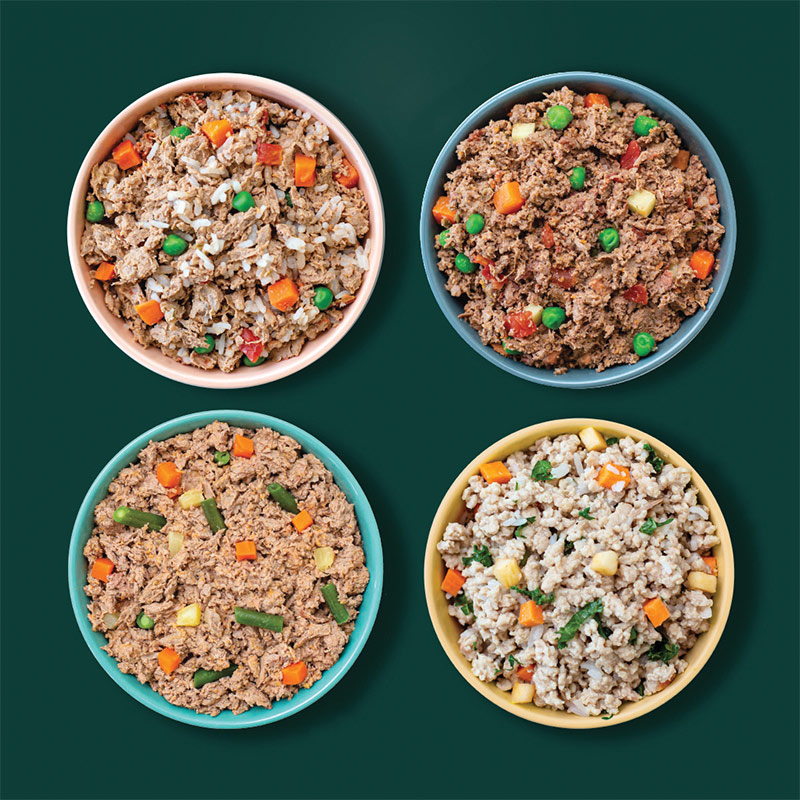 The format of the pet food, whether it’s dry, wet, fresh, frozen or dehydrated, presents different shelf-life challenges brands must address to ensure quality is maintained. (Source: A Pup Above)
The format of the pet food, whether it’s dry, wet, fresh, frozen or dehydrated, presents different shelf-life challenges brands must address to ensure quality is maintained. (Source: A Pup Above)
From start to finish
Whether a product is wet, dry or chewy, to maximize shelf life, you must start with quality raw materials. The less moisture in the ingredients when they are delivered to the pet food manufacturing facility, the easier they are to work with in terms of delivering on quality, as moisture invites deterioration.
“Manufacturers in rendering and pet food processing have many decisions to make when considering ingredient preservation and creating pet food products,” said Jim Mann, global platform manager, antioxidants and food safety, Kemin Industries, Des Moines, Iowa. “This includes how to prevent microbial growth, control pH and whether to use traditional or natural additives to prevent oxidation and improve shelf life and product stability.”
Microbial spoilage must be managed from the beginning to the end. Meat-based raw materials can degrade prior to manufacturing and reduce quality and impact animal health, especially in refrigerated products contaminated with pathogenic bacteria, such as Salmonella and Listeria. And, unfortunately, pathogens are invisible, which is why it is important that manufacturers take proper precautions to ensure safety. Mold, on the other hand, is visible and is reason to dispose of product. Any product that is not sterilized can have mold challenges if moisture or water activity are not controlled.
Heat and container matter
Retorting is the original cooking process to extend the shelf life of low-acid wet foods. The food is heated in hermetically sealed containers — cans were first, pouches and cartons came later — to destroy all spoilage and pathogenic microorganisms, thereby sterilizing the product. Aseptic processing also sterilizes product.
Retorting is a very economical process for manufacturing wet pet foods. However, the downside is that the high temperatures destroy heat-labile vitamins and may negatively impact product quality. It is these drawbacks that have fueled the growth of the fresh and frozen pet food categories, both of which still require proper cooking to destroy pathogenic microorganisms.
“Manufacturers should consider secondary shelf life (once the container is opened) and the consequences of packaging failures. This is where ingredients can cover the gap,” said Rob Ames, Corbion.
“Kill steps are basic and critical to food safety,” said Rob Ames, senior business development manager, Corbion, Lenexa, Kan. “Using them as shelf-life strategies can have merit and ultimately shrink the ingredient deck (as chemical preservatives are not necessary). Manufacturers should consider secondary shelf life (once the container is opened) and the consequences of packaging failures. This is where ingredients can cover the gap.”
Mann said, “Most of these ingredients are organic acids, or ingredients that produce organic acids. They can work by several mechanisms, either by acidifying the bacterial cells or by destroying cellular membranes.”
These ingredients are key to ensuring the shelf life and safety of refrigerated pet foods. They are especially useful in raw pet foods.
“These products are often less processed with a shorter shelf life, as compared to traditional wet and dry foods,” said Cynthia Rasmussen, business development manager, food protection and preservation, Kerry, Beloit, Wis. “Pet owners are looking for recognizable ingredients, leading more manufacturers to seek ingredients that both protect against microbial spoilage and perfect color, aroma and product palatability. New processing methods have helped improve food safety challenges.”
Vinicio Serment-Moreno, applications and food processing specialist, Hiperbaric, Doral, Fla., said, “Pets can be more resistant to pathogens, but they might inadvertently transfer them to owners through saliva, fur or feces, and owners can also spread pathogens in the kitchen by handling tainted utensils.”
This is where high-pressure processing (HPP) can assist. The HPP system involves the loading of airtight/hermetically sealed packages into an HPP vessel, where they are subjected to isostatic pressure (equal pressure on all sides), disrupting the microbial biochemistry of pathogens and spoilage bacteria, which helps preserve freshness and increase shelf life of perishable foods.
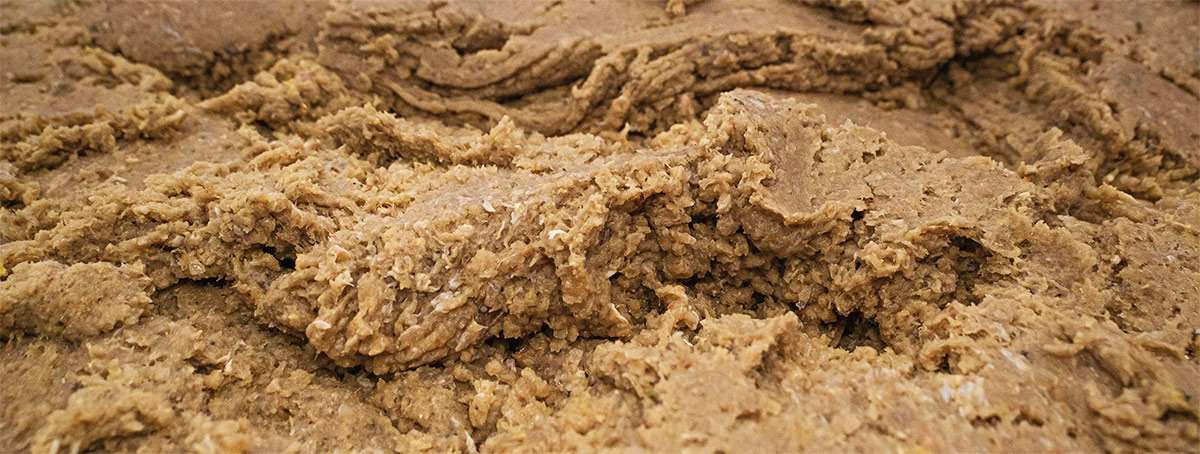 Product quality degradation must be addressed from the moment certain ingredients such as meat-based raw materials are initially processed. (Source: Sosland Publishing Co.)
Product quality degradation must be addressed from the moment certain ingredients such as meat-based raw materials are initially processed. (Source: Sosland Publishing Co.)
“Applying HPP reduces loads of hazardous bacteria, parasites and viruses, while keeping pet foods safe and nutritious,” Serment-Moreno said. “The HPP technology has minimal impact on the biochemical components of food like proteins and vitamins, ensuring that HPP pet foods meet the nutritional requirements of companion animals with improved sensory quality.”
Errol Raghubeer, senior vice president of research and development, Avure Technologies LLC, Middletown, Ohio, said, “Innovative processors use HPP to expand their distribution chain. In addition, HPP is strongly recommended as a food safety intervention step for raw pet foods. The technology preserves the flavor, texture and nutrients in raw food ingredients, and provides a safe alternative for immunocompromised dogs and cats who would otherwise not be able to eat a raw diet.”
A Pup Above, Austin, Texas, uses the sous vide process to gently cook its fresh human-grade dog foods to ensure safety and quality. Sous vide involves vacuum sealing food in specially designed pouches that get slow cooked in water at low temperatures until fully cooked.
“Our process includes product being quickly frozen just after being fully cooked,” said Ruth Stedman, co-founder and chief executive officer. “Keeping it frozen and closely monitoring our supply chain keeps our products fresh and wholesome for up to one year.”
Sensory shortcomings
While processing technologies address microbiological issues, they do not address other shelf-life issues. This includes sensory attributes such as appearance, aroma and texture.
“The gelling of the gravy, or separation of fat in canned wet food is a shelf-life issue, and syneresis of a product in low temperature is another one,” said Ellis Liu, technical manager, pet food segment, Ingredion Inc., Westchester, Ill. “Textural changes can contribute to a shortened shelf life of treats, whether it is due to the hardening of a semi-moist soft treat or the breakage of biscuits in bag.”
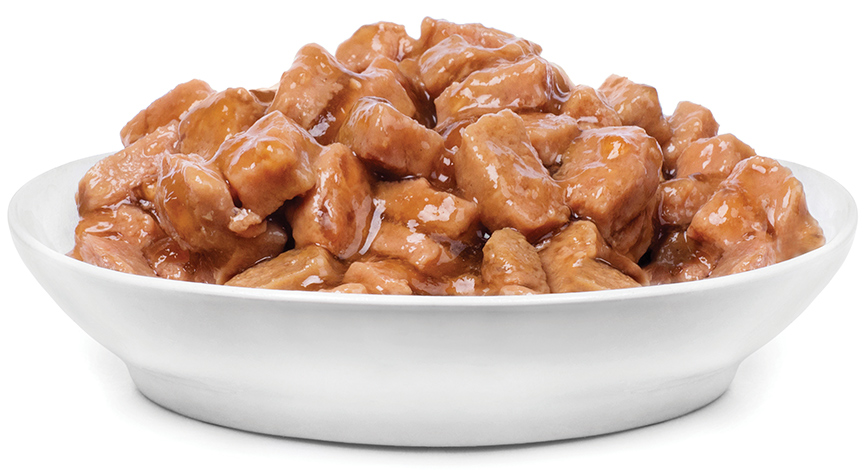 Gelling of the gravy, separation of fat and color changes are shelf-life challenges for wet pet food formats. (Source: ©KRAFLA - STOCK.ADOBE.COM)
Gelling of the gravy, separation of fat and color changes are shelf-life challenges for wet pet food formats. (Source: ©KRAFLA - STOCK.ADOBE.COM)
Ingredion offers solutions based on clean-label ingredients, such as corn, potato, tapioca, rice, pulses, fruits and gums to help solve texture challenges. This includes creating stable soft treats and reducing ice crystal growth on frozen wet food.
Another cause for shelf-life reduction happens somewhat behind the scenes, yet eventually is detectable by nose and mouth. It is the development of objectionable flavors and odors, described as rancid, through the degradation of fats and oils by oxidation. Because cat and dog foods tend to be high in essential fats, oxidation is a common problem, especially in kibble.
Rancidity is a natural process with degradation starting the moment the fat or oil comes into being. There is no way to prevent it, only to slow it, and there is no recovery. Fats degrade when fatty acids react with air, moisture or other compounds and break down into free fatty acids and other unstable compounds.
The main cause of rancidity is oxidative deterioration of unsaturated fatty acids by a free-radical chain process known as auto-oxidation. It occurs in three stages, with the first being the initiation. It is here where molecular oxygen combines with unsaturated fatty acids, producing hydroperoxides and peroxyl free radicals, both of which are highly reactive and unstable. The second stage is called propagation and occurs when these unstable byproducts of the first stage react with other lipids. This starts a chain reaction, with the reaction supplying its own accelerant.
At this point there is no turning back for the fat, as it is in a continuous cyclical oxidative degradation process that ends at the final stage, which is aptly known as termination. The cycle will cease, however, when an antioxidant enters the scenario. But at this point, any degradation that has occurred is permanent. The fat cannot repair itself. If objectionable flavors and odors have developed, they will remain.
“The higher the lipid content in the product, the higher the risk for oxidative deterioration,” said Mary Joe Fernandez, Layn Natural Ingredients.
“The higher the lipid content in the product, the higher the risk for oxidative deterioration,” said Mary Joe Fernandez, global vice president of sales and business development, Layn Natural Ingredients, Irvine, Calif. “Heat processed, non-refrigerated products are most susceptible, while frozen or canned products are less so. Cold slows down the chemical processes that unleash oxidative reactions.”
Mann said, “In canned foods, oxidation reactions can lead to color changes in food over time, leading to inconsistent appearance that can be perceived as a quality issue. Oxidation is a complex issue and can be managed through good understanding of the challenges and potential solutions.”
High temperature, light, water, metal ions and biological catalysts can accelerate the reaction. Further, the presence and placement of unsaturated fatty acids on the fat molecule influences the rate of degradation; thus, fat selection comes into play when taking steps to delay degradation. In general, the more polyunsaturated fatty acids on a fat molecule, the faster it will go rancid. This is due to the unstable double bonds that participate in the various degradation processes.
“Lipid oxidation issues are most prevalent in dry pet food products,” said Namal Senanayake, scientific manager, Camlin Fine Sciences, Urbandale, Iowa. “The dry foods manufacturing process — extrusion, baking, etc. — is expected to offer products with extended shelf life when stored in factory sealed bags. However, after opening for day-to-day use by the pet owner, various environmental factors may affect the physical and chemical properties of kibbles, especially when they are handled improperly or stored under perilous conditions.
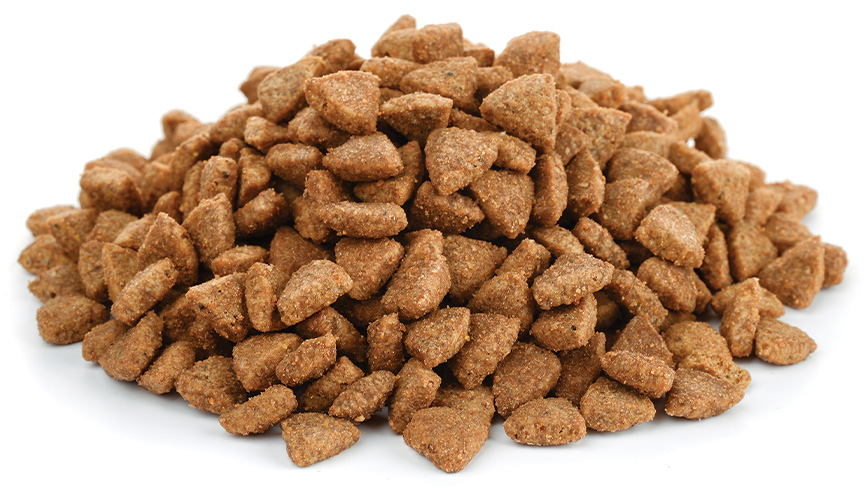 Fat oxidation that causes rancidity, which is of greater concern in dry products, cannot be reversed once it occurs, so the goal throughout processing, packaging, distribution and consumer use is to slow the natural process of oxidation. (Source: ©JIRI HERA - STOCK.ADOBE.COM)
Fat oxidation that causes rancidity, which is of greater concern in dry products, cannot be reversed once it occurs, so the goal throughout processing, packaging, distribution and consumer use is to slow the natural process of oxidation. (Source: ©JIRI HERA - STOCK.ADOBE.COM)
“The addition of antioxidants is vital to control for the oxidative deterioration of lipids and preserve essential nutrients,” Senanayake said.
Slowing down auto-oxidation
The most common approach to hinder lipid auto-oxidation is to include antioxidants in the formulation. This is often done at the ingredient level, with suppliers adding antioxidants to the fat or oil to slow the chain reaction from getting past the initiation stage. For extra protection, antioxidants may be sprayed on the surface of the product prior to packaging.
“The type of fat used, such as polyunsaturated fats in vegetable oil or saturated fats from beef tallow and chicken fat, and the properties of these fats and oils will determine how susceptible they are to oxidation,” McCarthy said. “There’s not a one-size-fits-all solution; different antioxidants work better for different applications. And when a product formulation changes, the antioxidant profile might have to be adjusted accordingly.”
Traditional synthetic antioxidants are very effective, easy to use and low cost. But being chemically derived, which is obvious by their names — i.e., ethylene diamine tetra acetic acid (EDTA), tertiary butyl hydroquinone (TBHQ), butylated hydroxyanisole (BHA) and butylated hydroxytoluene (BHT) — are undesirable in today’s clean-label environment.
In response, pet food manufacturers are embracing clean-label antioxidants that can be discreetly added to product formulations. Common options are classified as tocopherols, also known as vitamin E, and high-phenolic plant extracts, such as those sourced from rosemary, green tea and acerola.
Suppliers offer an array of clean-label antioxidants with various concentrations of active compounds. Usage level depends upon the product formula, storage conditions and desired shelf life.
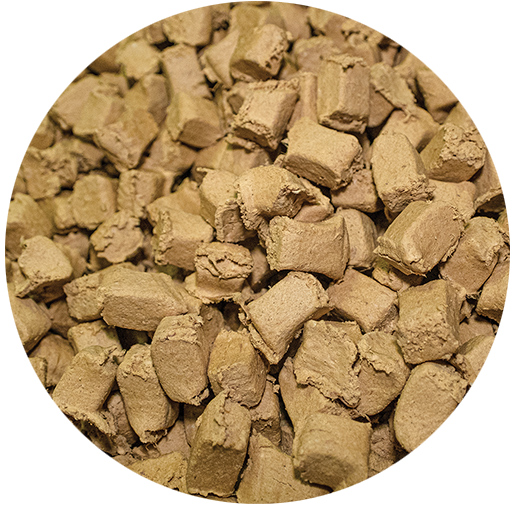 A freeze-dried product requires precise processing parameters to sufficiently inhibit bacteria for the expected life of the product. (Source: Sosland Publishing Co.)
A freeze-dried product requires precise processing parameters to sufficiently inhibit bacteria for the expected life of the product. (Source: Sosland Publishing Co.)
“Antioxidants have the flexibility of being applied at any stage of a process,” Senanayake said. “Liquid products can be either oil- or water-soluble. Oil soluble antioxidants can be easily incorporated into the oil phase of the formulations. The powder form of antioxidants may be preferred for certain formulations containing dry ingredients, as they facilitate easier blending.”
Fernandez said, “Botanical extract solutions combine ingredients that have different mechanisms of anti-oxidation at various points of the oxidative chain, resulting in enhanced efficacy through synergies to slow spoilage and protect the substrate, thereby extending shelf life and helping to reduce food waste.”
In addition to adding antioxidants to delay lipid oxidation, it is often necessary to use specially treated nutrients. This includes essential minerals that participate in metal-induced oxidation.
“Providing a complete-and-balanced diet to pets means that manufacturers include vitamins and trace metals into pet food,” said Tayler Hansen, Ph.D., companion animal nutritionist, Trouw Nutrition USA, Highland, Ill. “Trace metals are highly reactive and have a strong redox potential. They can oxidize other ingredients like vitamins and fat, reducing product shelf life.”
Trouw Nutrition helps pet manufactures balance the reactivity of ingredients with the nutritional needs of the pet. This includes offering chelated organic trace minerals to minimize reactions.
“The reactive trace metal is bound to a partner like an amino acid,” Hansen said. “When this bond is strong, the trace metal is less likely to interact with other ingredients in pet food, which improves product shelf life.”
Read more about product development, ingredients and formulation.





